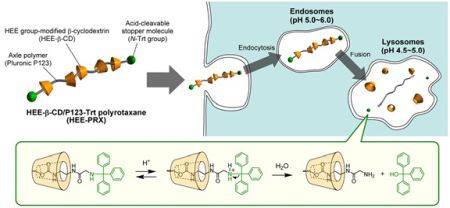|
|
|
|
|
|
| Researchers in Japan have improved a potential treatment for a rare genetic disease, decreasing its negative toxic effects by threading it onto a dumb-bell-shaped chain and holding it in place until it reaches its target. |
TSUKUBA, Japan, Nov 3, 2016 - (ACN Newswire) - The by-products of cellular processes need to be removed and degraded for cells to function normally. Tiny spherical vesicles, called lysosomes, act as the cell's main waste disposal system. Genetic abnormalities that affect them lead to waste accumulation inside cells.
 | | HP-beta-CD delivery to lysosomes via a dissociative polyrotaxane. |
Niemann-Pick type C (NPC) disease is a rare genetic disorder that affects two proteins that play a central role in transporting cholesterol from lysosomes to other parts of the cell. Accumulation of cholesterol inside lysosomes leads to fatal symptoms, such as progressive nerve degeneration, and enlargement of the liver and spleen.
A team of researchers at Tokyo Medical and Dental University are working to improve the efficiency of a drug that has received much attention due to its strong ability to reduce cholesterol in cells affected by NPC. However, high concentrations of these potentially therapeutic ring-shaped sugar molecules, called HP-beta-CD (2-hydroxylpropyl-beta-cyclodextrin), were found to be highly toxic in mice.
The researchers developed a strategy to deliver HP-beta-CD to lysosomes without affecting other cell structures. They did this by threading the ring-shaped HP-beta-CDs onto a dumb-bell-shaped molecule, called polyrotaxane. A "stopper", called N-Trt (N-triphenylmethyl), is present at either end of the polyrotaxane molecule, keeping the HP-beta-CD in place on its polyrotaxane thread. The team also added a molecular component, called an HEE group (2-(2-hydroxyethoxy)ethyl), to the HP-beta-CD part of the compound, making it more soluble in water.
The team found that the N-Trt stoppers were broken off when the compound reached the acidic environment of the lysosomes, but stayed mainly intact in the largely neutral environment of the surrounding cell. They also found that the compound reduced cholesterol levels inside cells best when 4.1 to 5.4 HEE groups were added per single beta-CD. When the number of HEE groups was increased, the compound was unable to reduce cholesterol content. Finally, the compound showed negligible toxicity in normal human skin cells called fibroblasts, even at relatively high concentrations.
The team's compound has "great potential to improve lysosomal cholesterol accumulation in NPC disease without marked toxicity," conclude the researchers in their study published in the journal Science and Technology of Advanced Materials.
For further information please contact:
Professor Nobuhiko Yui,*
Department of Organic Biomaterials, Institute of Biomaterials and Bioengineering, Tokyo Medical and Dental University, Tokyo, Japan
*E-mail address: yui.org@tmd.ac.jp
Article information
Atsushi Tamura, Kei Nishida, and Nobuhiko Yui,
"Lysosomal pH-inducible supramolecular dissociation of polyrotaxanes possessing acid-labile N-triphenylmethyl end groups and their therapeutic potential for Niemann-Pick type C disease",
Science and Technology of Advanced Materials 17 (2016) 361-374.
http://dx.doi.org/10.1080/14686996.2016.1200948
http://tandfonline.com/doi/full/10.1080/14686996.2016.1200948
Journal information
Science and Technology of Advanced Materials (STAM, http://www.tandfonline.com/toc/tsta20/current) is an international open access journal in materials science. The journal covers a broad spectrum of topics, including synthesis, processing, theoretical analysis and experimental characterization of materials. Emphasis is placed on the interdisciplinary nature of materials science and on issues at the forefront of the field, such as energy and environmental issues, as well as medical and bioengineering applications.
For more information about STAM contact
Mikiko Tanifuji
Publishing Director
Science and Technology of Advanced Materials
E-mail: TANIFUJI.Mikiko@nims.go.jp
Press release distributed by ResearchSEA for Science and Technology of Advanced Materials.
Topic: Research and development
Source: Science and Technology of Advanced Materials
Sectors: Materials & Nanotech, Science & Research, BioTech
http://www.acnnewswire.com
From the Asia Corporate News Network
Copyright © 2026 ACN Newswire. All rights reserved. A division of Asia Corporate News Network.
|
|
|

|
|
|
|
| Science and Technology of Advanced Materials |
| July 8, 2025 06:48 HKT/SGT |
|
Progress towards potassium-ion batteries |
| June 23, 2025 00:15 HKT/SGT |
|
New method to blend functions for soft electronics |
| May 5, 2025 03:20 HKT/SGT |
|
New Database of Materials Accelerates Electronics Innovation |
| Jan 28, 2025 08:00 HKT/SGT |
|
High-brilliance radiation quickly finds the best composition for half-metal alloys |
| Dec 3, 2024 23:15 HKT/SGT |
|
Machine learning used to optimise polymer production |
| Oct 25, 2024 23:00 HKT/SGT |
|
Machine learning can predict the mechanical properties of polymers |
| July 30, 2024 20:00 HKT/SGT |
|
Dual-action therapy shows promise against aggressive oral cancer |
| Apr 17, 2024 22:00 HKT/SGT |
|
A new spin on materials analysis |
| Apr 12, 2024 18:00 HKT/SGT |
|
Kirigami hydrogels rise from cellulose film |
| Feb 27, 2024 08:00 HKT/SGT |
|
Sensing structure without touching |
| More news >> |
 |
|
|